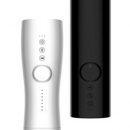Tomorrow’s Programmable Matter Sextoys Will Be Everything We Want—Whenever We Want It
Say hello to a world of infinitely adaptable smart plastic pleasure devices

If things continue the way there are now—and there’s lots of evidence that they will—in a few years we may be seeing a whole range of objects with the ability to become practically anything.
From fabrics resembling metal or even wood, these smart materials will be able to change color, shape. and even texture. They’ll be able to morph into whatever we’ll need in an instant.
The sexual possibilities, to put it lightly, could be tremendous.
Welcome to the world of programmable matter

Currently, the state of programmable matter is still in its infancy. But researchers are optimistic that with forthcoming breakthroughs, we will soon be seeing a transformable future.
There is a range of approaches to creating substances that can be altered on command. One way is using electromagnetic fields to interact with materials suffused with ferromagnetic particles. Turn on the juice and the stuff could take on an array of useful shapes.
Another approach is what is called claytronics: basically a form of nanotechnology where a substance is mostly made up of atom-sized machines.
RECOMMENDED READ: With Sugar on Top: Tasty New VR Tech Flavors the Future
Then there’s the idea of smart plastics. Here the idea is the material would, after receiving a programmed command, expand or contract like artificial muscles. There’s even the possibility it could change color using something like the synthetic version of an octopus’s chromatophores, microscopic dots of color that can be switched on and off to create almost any hue desired.
A shape-changing future

The implications for programmable matter are astounding. Why have a whole toolbox when you can one nanotech device that can become whatever you need when you need it?
Why have a wardrobe full of clothes when a single garment can shift from summer to winter wear at a moment’s notice? Why have a house full of gadgets when one programmable blob of plastic can transform into anything on command? Why have a dressing that needs to be adjusted and changed when you can have a bandage that not only monitors your injury, but applies or decreases pressure and heat to optimize healing?
True, some of this is probably some decades away. But even extrapolating only a few years ahead, the potential for programmable materials is still intriguing—especially when it comes to programmable materials and sex.
The ultimate sex toy

For one thing, imagine a sex toy smart enough not just to learn what you like but also be able to become what you need. Smoothly, seamlessly, it could gain or loose texture, get warmer or colder, or expand or contract by reading your level of arousal.
A programmable matter sexbot could, when not in use, look like a generic figure. But switched on it could morph into a lifelike copy of whoever or whatever you want.
Let’s say you have a long-distance lover. They hook up to a transmission system and connect your robot’s sensory input to wherever they might be. In response, your bot’s smart plastic outer covering becomes a facsimile of their real self—or whatever you and they decide would be fun to play with that day.
As the tech grows even more advanced, it’s possible that our clothing—in addition to being able to change style on a whim—could become a form of wearable sex tech. Feeling amorous? The very fabric you are wearing could contract, expand, or actually even move in a way to scratch that itch.
And, beyond even that, there might be an age when many humans have become cyborgs; replacing their original organic organs with programmable matter parts. For them, their genitals could be whatever they desired them to be, for whatever sex they wanted to have. It would be an age of nearly limitless possibilities—limited only by imagination.
The only certainty is change

While it’s unclear exactly what form the materials of the near and far future may take, one thing is certain: with the way things are going, it will be a world where the only definite thing is that it will be changeable.
Image sources: Depositphotos
Leave a reply
You must be logged in to post a comment.

















